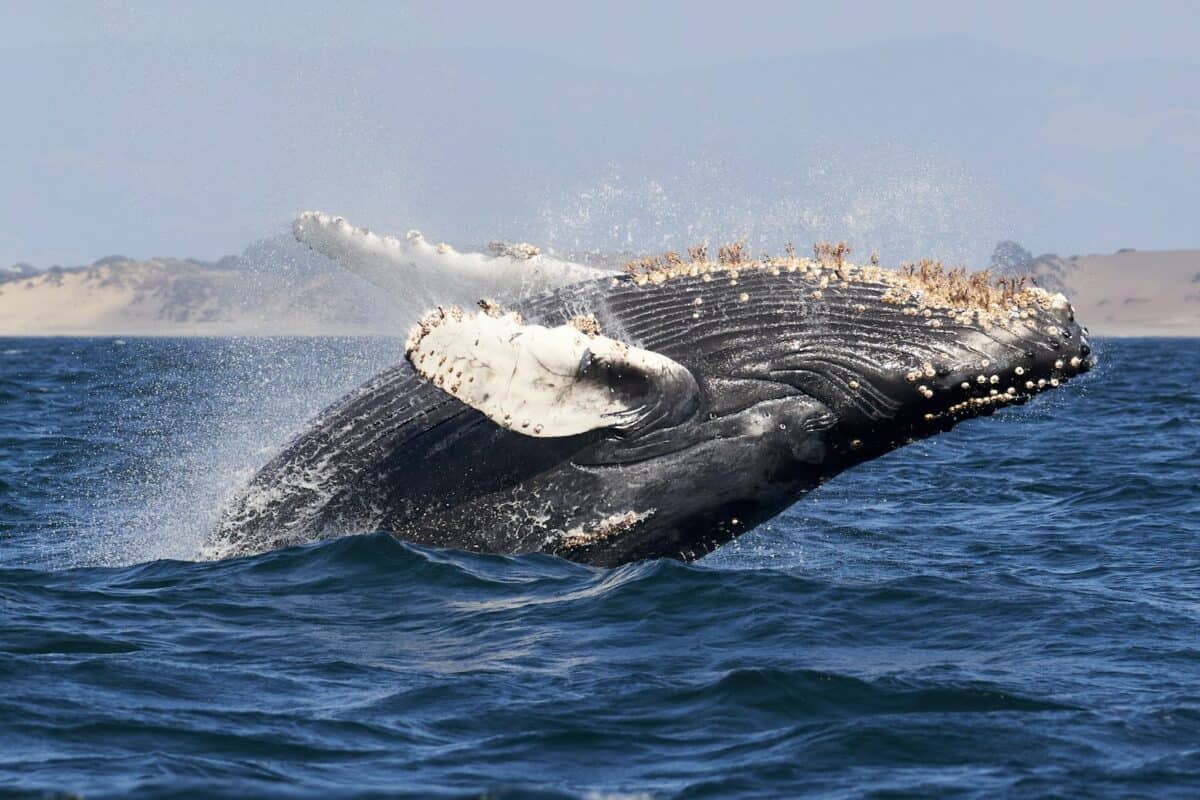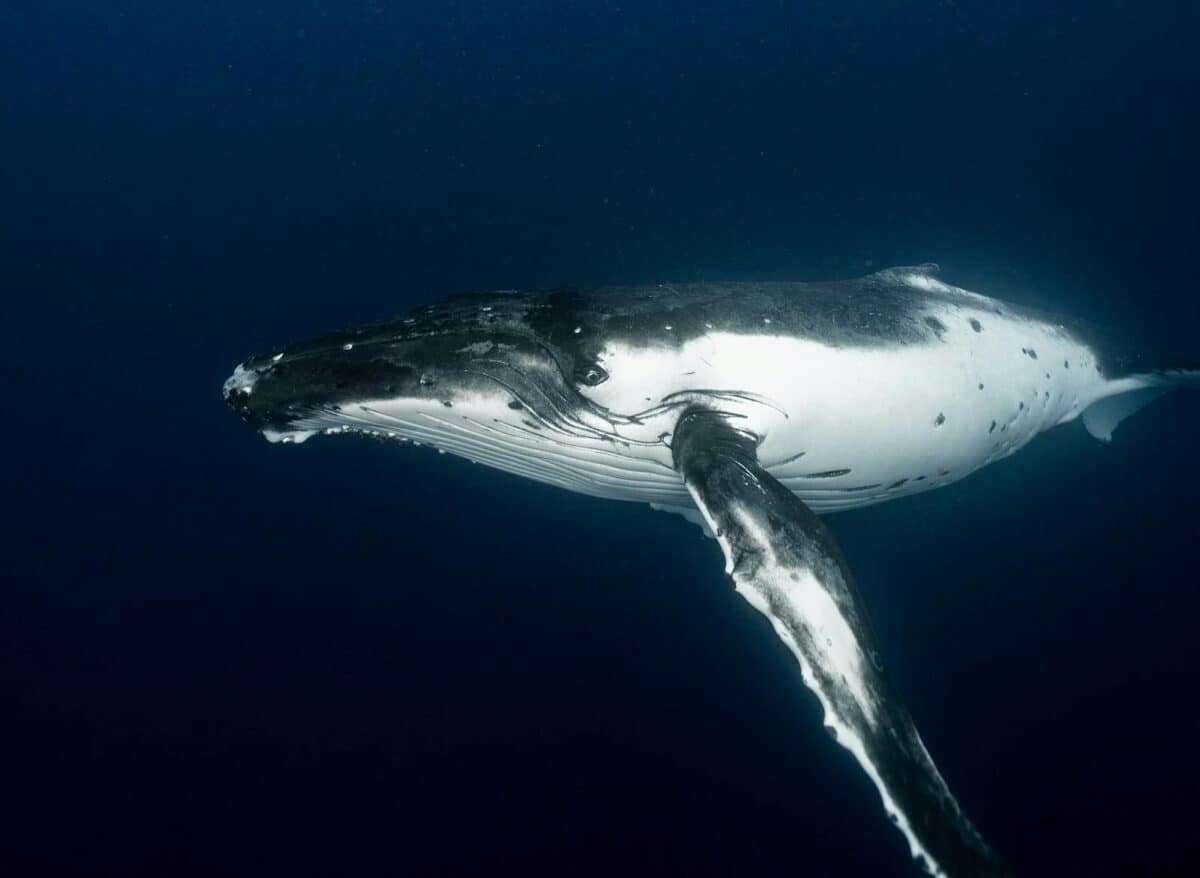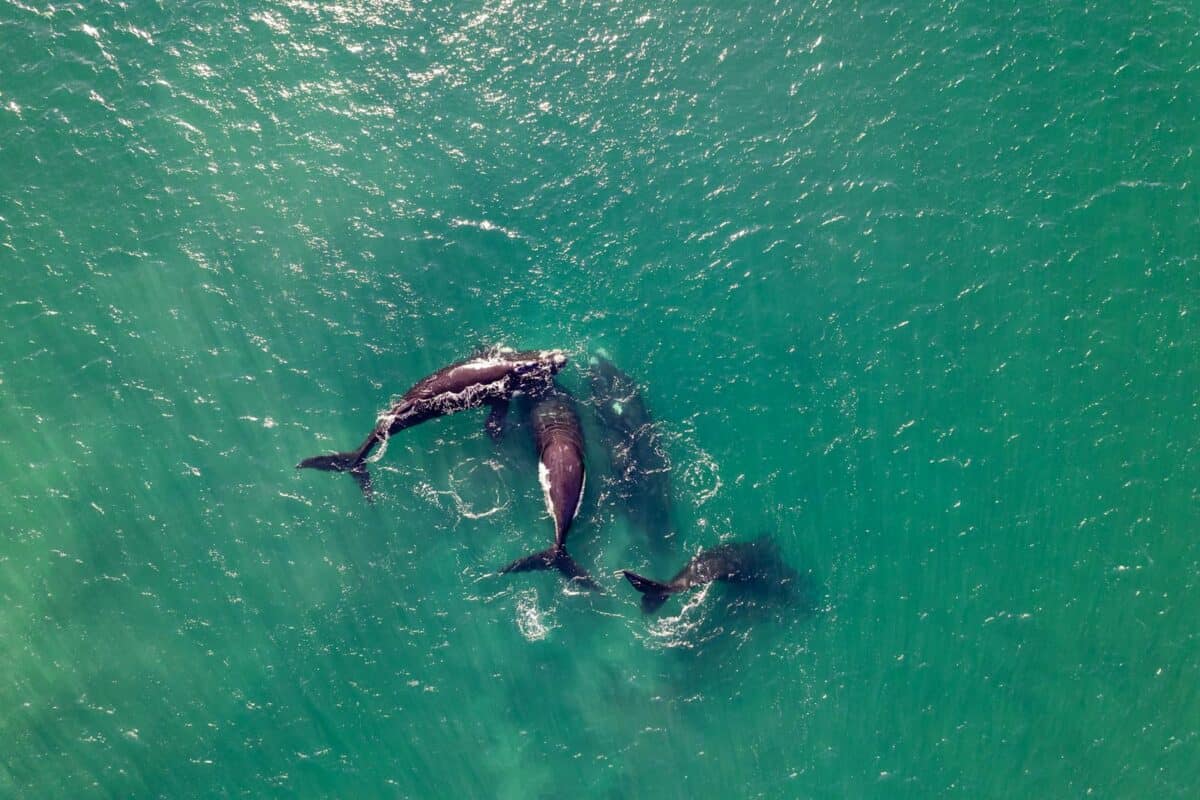In the blue depths of our oceans, an extraordinary phenomenon has been documented with increasing frequency over the past decade: humpback whales intervening in orca (killer whale) attacks on other marine species. These massive marine mammals, known primarily for their haunting songs and spectacular breaching displays, have repeatedly been observed putting themselves at risk to protect seals, sea lions, gray whale calves, and even unrelated species like sunfish and harbor porpoises from predatory orcas. This altruistic behavior has fascinated marine biologists and challenged our understanding of interspecies relationships in the ocean. What drives these gentle giants to become guardians of the sea? Is it misdirected maternal instinct, species memory, or something even more complex? Join us as we dive into the fascinating world of humpback whale interventions and explore one of the ocean’s most mysterious and heartwarming phenomena.
The Unexpected Guardians: Introducing Humpback Whales

Humpback whales (Megaptera novaeangliae) are magnificent cetaceans known for their impressive size—growing up to 60 feet long and weighing approximately 40 tons. Despite their massive bulk, these baleen whales feed primarily on tiny krill and small fish, using their distinctive feeding strategy called bubble-net feeding. Their peaceful nature makes their interventions against the ocean’s apex predators all the more remarkable.
Humpbacks are highly intelligent creatures with complex social structures and communication systems, including their famous “songs” that can last for hours and travel for miles underwater. These traits contribute to their ability to recognize threats not just to themselves but apparently to other species as well. With their enormous pectoral fins (the longest of any whale species, reaching up to 16 feet), powerful tails, and sheer body mass, humpbacks possess the physical tools needed to confront even the most formidable oceanic predators—tools they increasingly appear willing to use in defense of others.
The Skillful Hunters: Understanding Orca Predation

Orcas, or killer whales (Orcinus orca), are the ocean’s apex predators, known for their intelligence, social complexity, and sophisticated hunting techniques. These toothed whales hunt in coordinated pods, using strategies that vary between different populations. Some specialize in hunting fish, while others—particularly transient orcas—target marine mammals including seals, sea lions, and even other whale species. Their hunting methods can be both brutal and efficient: they’ve been observed creating waves to wash seals off ice floes, coordinating attacks to exhaust larger prey, and even intentionally beaching themselves temporarily to capture prey on shorelines.
Despite being smaller than humpbacks (typically 20-26 feet long), orcas possess powerful jaws lined with 4-inch teeth designed for ripping flesh. Their predatory prowess and pack hunting make them formidable opponents, which makes the humpbacks’ willingness to intervene all the more remarkable. The relationship between these two species is complex—while orcas rarely attack adult humpbacks, they do occasionally target humpback calves, creating an evolutionary basis for the antagonism between these marine giants.
The Documented Evidence: Case Studies of Intervention

Marine biologists have compiled numerous documented cases of humpback interventions since the early 2000s. One of the most compelling studies, published in Marine Mammal Science by Robert Pitman and his colleagues, analyzed 115 documented interactions between humpbacks and orcas, finding that in many cases, the humpbacks appeared to be deliberately interfering with orca hunts.
In the Monterey Bay region, researchers observed humpbacks charging into groups of hunting orcas, trumpeting loudly (making a loud snorting sound through their blowholes), and even using their massive pectoral fins to slap the water or strike at the orcas. In Antarctic waters, a particularly dramatic case involved humpbacks lifting a seal onto their backs, effectively shielding it from attacking orcas. Off the coast of Western Australia, observers documented humpbacks forming a defensive circle around a gray whale calf under attack, using their bodies as a living barrier between the vulnerable calf and the hunting orcas.
Similar interventions have been observed in South African waters, the South Pacific, and throughout the North Pacific, suggesting this is not a localized phenomenon but a widespread behavioral pattern. Particularly striking is that these interventions often occur when the prey is not a humpback whale—the humpbacks appear to be going out of their way to protect entirely different species.
Mobbing Behavior: The Humpback Defense Strategy

When humpback whales intervene in orca attacks, they typically employ what scientists call “mobbing behavior”—a defensive strategy observed in many species where multiple individuals confront a predator to drive it away. For humpbacks, this mobbing takes several forms. They often approach in groups, surrounding the orcas and their intended prey.
They produce loud vocalizations—trumpeting, bellowing sounds that may serve to intimidate or confuse the hunters. Physical intimidation is another key tactic: humpbacks will raise their massive pectoral fins, slap them against the water surface, and perform tail lobs (powerful slaps of their flukes against the water) that create thunderous sounds and turbulence. In more aggressive interventions, humpbacks have been observed charging directly at orcas, sometimes making physical contact by ramming or swatting them with their fins. This behavior puts the humpbacks at considerable personal risk, as orcas could potentially retaliate.
The mobbing can last from minutes to hours, and often continues until the orcas abandon their hunt and move away from the area. What’s particularly fascinating is how coordinated these interventions can be, with multiple humpbacks seeming to work together in their defensive actions, suggesting a level of cooperation and tactical awareness that challenges our understanding of cetacean cognition.
Maternal Instinct or Something More? Theories Behind the Behavior

Scientists have proposed several theories to explain this seemingly altruistic behavior. The most straightforward explanation suggests that humpbacks have evolved an instinctive response to orca vocalizations associated with attacks, particularly because orcas occasionally prey on humpback calves. This “maternal protection hypothesis” proposes that humpbacks may be responding to a perceived threat to their own young, and in the heat of the moment, extend this protection to other species.
Some researchers, however, argue this doesn’t fully explain why male humpbacks (not just females) engage in interventions, or why they protect species they wouldn’t normally interact with. Another theory focuses on “reciprocal altruism” or broader ecosystem benefits—by disrupting orca hunting patterns generally, humpbacks might be creating a less threatening environment for their own species in the long run. Some biologists have even suggested the possibility of spite as a motivation—humpbacks may simply have evolved to dislike orcas due to the threat they pose to calves, and interfere with their hunts as a form of antagonism.
The most complex explanation involves cultural learning and empathy—the possibility that humpbacks have developed a cultural tradition of intervention that gets passed down through generations, possibly involving some form of cross-species empathy. The truth likely involves a combination of these factors, and continues to be a subject of fascinating research.
The Protected Species: Who Benefits from Humpback Heroism

The range of marine species that have benefited from humpback interventions is surprisingly diverse. The most commonly protected animals include seals and sea lions, with numerous documented cases of humpbacks shielding harbor seals, Weddell seals, and California sea lions from hunting orcas. Gray whale calves are another frequent beneficiary—particularly vulnerable during their migrations, these young whales and their mothers often receive protection from groups of intervening humpbacks.
More unusually, scientists have documented humpbacks protecting harbor porpoises, which are much smaller cetaceans unrelated to humpbacks, and even sunfish (Mola mola), a large bony fish that bears no resemblance to whales at all. In one remarkable observation off the coast of Hawaii, humpbacks appeared to shield a Cuvier’s beaked whale from orcas—particularly notable as beaked whales are deep-diving cetaceans that rarely interact with either humpbacks or orcas.
These diverse rescue efforts challenge simple explanations based on species similarity or relatedness, suggesting that humpbacks’ protective behavior may be broader and more generalized than initially thought—perhaps triggered by the distress vocalizations of the prey or the hunting calls of the orcas themselves, rather than by recognition of the specific species under attack.
The Global Phenomenon: Where These Interventions Occur

Humpback whale interventions against orca attacks have been documented across the world’s oceans, making this truly a global phenomenon. Notable hotspots include the waters off Monterey Bay, California, where the abundance of both humpbacks and transient orcas creates frequent opportunities for interaction. The Antarctic’s southern ocean waters have yielded several dramatic documented cases, particularly during the austral summer when humpbacks feed in these productive cold waters.
Australian waters, particularly off the continent’s western coast, have been the site of multiple observed interventions, often during the annual gray whale migrations when calves are vulnerable. Other significant locations include the waters around South Africa’s coast, the South Pacific regions near Tonga and New Zealand, and the north Pacific, including waters off Alaska and British Columbia.
Interestingly, these interventions seem to occur in both feeding and breeding grounds of humpbacks, suggesting the behavior isn’t limited to particular life stages or seasonal activities. The global distribution of these events offers researchers valuable comparative data, allowing them to identify patterns and consistencies in the behavior across different humpback populations that may otherwise have limited genetic or cultural exchange with each other.
The Historical Context: Evolution of Interspecies Relationships

The antagonistic relationship between humpbacks and orcas likely dates back millions of years, evolving throughout the Cetacean lineage’s development. Fossil evidence suggests orcas and their ancestors have been predators of whale calves for at least 5 million years, creating strong evolutionary pressure for defensive behaviors in larger whale species.
Indigenous knowledge from maritime cultures around the world contains references to whales fighting or defending against killer whales, suggesting human awareness of these dynamics predates scientific documentation. In the modern era, commercial whaling drastically reduced humpback populations during the 19th and 20th centuries, potentially disrupting natural behavioral patterns and cultural transmission among whale populations. As humpbacks have recovered following the 1986 international whaling moratorium, scientists have had more opportunities to observe these complex interspecies interactions.
Interestingly, historical ship logs and naturalist accounts from the 1800s occasionally mention large whales interfering with killer whale hunts, suggesting this behavior isn’t new, though modern observation technology and research efforts have dramatically improved documentation. Understanding the historical trajectory of these interactions helps contextualize current observations and raises intriguing questions about how marine mammal behaviors may have been altered by human impacts and subsequent recovery efforts.
The Cognitive Question: Humpback Intelligence and Decision-Making

The interventionist behavior of humpbacks raises profound questions about cetacean cognition and decision-making capabilities. Humpback whales possess large, complex brains with an expanded neocortex—the brain region associated with higher cognitive functions in mammals. Their brains contain specialized cells called spindle neurons (previously thought to exist only in humans and great apes) that are linked to social awareness, empathy, and intuitive decision-making.
When a humpback intervenes in an orca attack, it must process multiple streams of information: identifying the predator, assessing the threat, determining appropriate responses, and potentially coordinating with other humpbacks. This suggests sophisticated situational awareness and real-time adaptive behavior. The fact that humpbacks sometimes travel considerable distances to reach the site of an attack indicates they can localize sounds with precision and make deliberate decisions to approach potential conflict.
Some researchers propose that these interventions demonstrate a form of empathy—the ability to recognize distress in another being and take action to alleviate it. Whether this represents true cross-species empathy or a more instinctive response remains debated, but the complexity and contextual flexibility of these interventions suggest cognitive processes beyond simple reflexive behaviors. Neurobiological research on cetacean brains, combined with behavioral studies, continues to expand our understanding of these magnificent creatures’ mental capabilities.
The Risk Factor: Dangers Humpbacks Face When Intervening

When humpback whales intervene against orcas, they place themselves at considerable personal risk. While adult humpbacks are generally too large for orcas to consider as prey, the intervention brings them into close proximity with the ocean’s most formidable predators. Documented encounters show orcas responding aggressively to intervening humpbacks, sometimes redirecting their attack toward the larger whales.
Orcas have been observed attempting to separate humpback groups, possibly trying to isolate weaker or younger individuals. The physical confrontations can lead to injuries for the humpbacks—researchers have documented rake marks from orca teeth on the bodies and fins of humpbacks known to engage in interventions. Particularly concerning is the energy expenditure required for these confrontations. Humpbacks may expend precious caloric resources during interventions, which could be especially costly during migration periods when they’re already living off fat reserves. For mother humpbacks with calves, intervention creates another significant risk: leaving their own calf temporarily more vulnerable.
This willingness to accept personal risk makes the behavior all the more remarkable from an evolutionary perspective. Standard natural selection models would generally favor self-preservation, particularly when the beneficiary of risky behavior is an unrelated species that offers no obvious reciprocal benefit. This apparent altruism at personal cost represents one of the most fascinating aspects of these interventions.
Scientific Challenges: Studying Unpredictable Ocean Behavior

Researching humpback interventions presents scientists with significant challenges. The unpredictable nature of these events makes them difficult to study systematically—researchers can’t plan when or where an intervention will occur, forcing them to rely heavily on opportunistic observations. The ocean environment itself creates logistical difficulties: limited visibility underwater, challenging weather conditions, and the vast geographic range where these events might occur.
Ethical considerations prevent experimental setups that would put animals at risk, meaning researchers must use non-invasive observation methods. Documentation typically relies on a combination of approaches, including drone footage, underwater acoustics to capture vocalizations, boat-based observations, and increasingly, citizen science reports from whale watching operations and recreational boaters. Interpreting the behavior presents another challenge—scientists must be careful not to anthropomorphize or project human motivations onto the whales, while still recognizing the complexity of their behaviors.
Distinguishing between intentional intervention and coincidental presence requires careful analysis of movement patterns, vocalizations, and contextual factors. Long-term studies tracking individual humpbacks over time may help determine whether certain individuals are more likely to intervene than others, potentially revealing personality differences or learned behaviors within humpback populations. Despite these challenges, advances in tracking technology, underwater acoustics, and machine learning analysis of behavior patterns are helping scientists gradually build a more complete picture of this remarkable phenomenon.
Conservation Implications: What This Behavior Tells Us About Ecosystem Balance

The interventionist behavior of humpbacks may have significant implications for marine ecosystem dynamics and conservation strategies. By interfering with orca predation, humpbacks potentially influence predator-prey relationships and population dynamics of multiple species. Some marine biologists suggest these interventions could function as a form of ecosystem engineering—humpbacks inadvertently creating safer spaces for certain prey species, which might in turn affect those species’ behaviors and distributions.
As oceans face unprecedented threats from climate change, pollution, and habitat destruction, understanding these complex interspecies relationships becomes increasingly important for conservation planning. The recovery of humpback whale populations following the whaling moratorium represents one of conservation’s great success stories—many populations have rebounded from near extinction to near historic levels. This recovery may have restored ecological interactions that were previously diminished or absent during the whaling era. From a conservation perspective, the protective behavior underscores the importance of viewing marine ecosystems holistically rather than focusing on single-species management.
The interventions highlight the complex web of relationships between marine species and suggest that the loss of one species—like humpbacks—could have cascading effects beyond the obvious ecological roles they play as consumers and nutrient cyclers. As marine protected areas are planned and implemented, consideration of these behavioral dynamics might inform more effective conservation strategies that preserve not just species, but the intricate behavioral interactions between them.
- How the Global Pet Trade Is Threatening Exotic Animals in the Wild - August 20, 2025
- Crocodiles Are Closer to Dinosaurs Than Birds - August 20, 2025
- Echidnas Use Electroreception to Hunt - August 20, 2025

